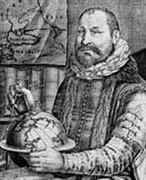Person: Girard, Albert

Albert Girard was a French mathematician and musician. His work on trigonometry is the first to use the abbreviations sin, cos, tan.
Mathematical Profile (Excerpt):
- Jacob Golius was about the same age as Girard but began studying mathematics at the University of Leiden some years earlier.
- We know however that by the time Huygens wrote this letter, Girard was serving as an engineer in the army of the Prince of Orange, Frederick Henry of Nassau.
- Girard worked on algebra, trigonometry and arithmetic.
- Stevin had produced tables of sines, tangents and secants which were greatly improved by Girard who published his version in 1626.
- Girard gives the triangle later known as Pascal's triangle and uses it as the basis for developing a theorem on symmetric functions, although he has no idea of them as such.
- Girard calls Pascal's triangle the "triangle of extraction".
- Since the highest power of the unknown is 4, Girard states clearly that there are four roots "neither more nor less".
- Like many mathematicians of his day Albert Girard was interested in military applications of mathematics and in particular studied fortifications.
- It appears that Girard spent some time as an engineer in the Dutch army although this was probably after he published his work on trigonometry.
- Girard worked on producing Les Oeuvres mathématiques de Simon Stevin augmentées par Albert Girard but died in 1632 before the work was published; this happened in 1634.
- Hence the 'Oeuvres' can be used to study Stevin's own thought, but one must be careful not to ascribe Girard's unmistakable interpolations to Stevin.
- Sarton notes that Girard wrote a "strange commentary" on Stevin's ideas on the "age of wisdom".
- The second thing which Albert Girard mentions, is a way of exhibiting a series of rational fractions, that converge to the square root of any number proposed, and that very fast.
- Girard cannot be credited with the invention of continued fractions as a result of his brilliant observations but again his genius shines through.
- One is left with a little sadness that Girard's name is not today well-known yet one feels that things could have been different if he had taken the time to fully explain the things he obviously understood and also taken some time to push a little further some of his amazing insights.
Born 1595, St Mihiel, France. Died 8 December 1632, Leiden, Netherlands.
View full biography at MacTutor
Tags relevant for this person:
Algebra, Analysis, Geometry, Number Theory, Special Numbers And Numerals
Thank you to the contributors under CC BY-SA 4.0! 

- Github:
-

- non-Github:
- @J-J-O'Connor
- @E-F-Robertson
References
Adapted from other CC BY-SA 4.0 Sources:
- O’Connor, John J; Robertson, Edmund F: MacTutor History of Mathematics Archive
